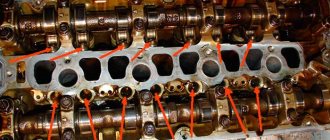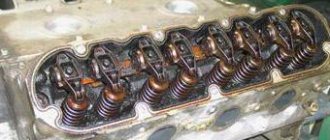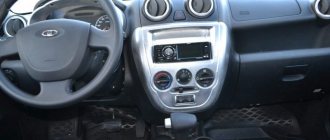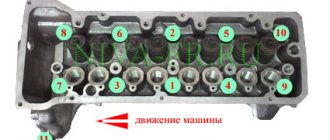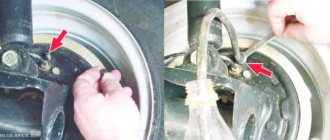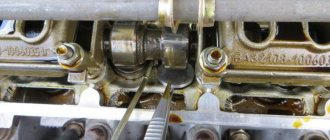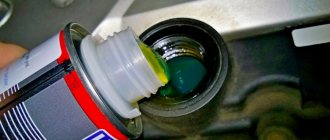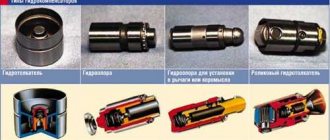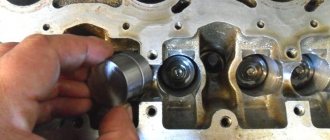Hydraulic compensators: what are they and where are they located?
These elements are an important part of the gas distribution mechanism. These hydraulic compensators can be found directly above the valve. To be more precise, under the camshaft cam.
This part looks like a cylinder. Inside it there is a special check valve, a plunger pair, and a spring. Special channels are made in the walls of the hydraulic compensator. They serve to circulate oil.
Causes of knocking hydraulic compensators
Experts identify three popular causes of knocking that are typical for parts of the gas distribution mechanism:
- problems with the operation of the engine lubrication system;
- wear or mechanical failure of hydraulic compensators;
- use of inappropriate lubricant or loss of lubricant properties.
For ease of understanding, such parts are usually considered as ordinary plunger pairs that interact with engine oil. After prolonged and intensive use, the surface may become deformed due to wear.
Additional negativity can cause the oil supply valves to hang, which ultimately leads to loss of unit performance. In some cases, the valve that provides the oil supply becomes jammed.
Drivers should be aware of the consequences of airing the lubrication system due to a lack of working fluid. The consequences manifest themselves in the form of knocking noise from operating hydraulic compensators, because unlike incompressible oil, air is easily compressed.
Overfilling the system with oil is also dangerous. Excess fluid may foam during operation of the oil pump, which will begin to function intermittently.
Significant contamination of the lubrication system can cause timing noise. All contaminant particles and deposits penetrate inside the HA. This happens when the oil filter is clogged and the bypass valve remains open, through which contaminated flow flows.
Tapping can occur in a car filled with lubricant that does not correspond to the current season, is not suitable for a specific engine model in terms of viscosity, or is a poor-quality product. In such cases, sounds will be heard both on a hot engine and on a cold one.
Function of hydraulic compensators in the engine
During operation of a car engine, every part of it heats up to high temperatures. The valves are also subject to heat. If you remember the physics course, then at the moment of heating the body expands. This means that the gaps between the valves and rocker arms in the valve mechanism will inevitably decrease.
On older car models with simpler engine designs, valve clearances were adjusted manually. This is not a difficult job, but it requires certain skills, knowledge and a set of tools to complete it. If the gaps are adjusted incorrectly or at the wrong time, certain problems will arise. One of them is a knock, which is familiar to every owner of such a car. This noise indicates that the gaps are too large.
Small gaps also led to certain problems. Because of this, the valve did not close tightly. It was necessary to adjust the mechanisms quite often, since during the operation of the motor the settings were constantly lost.
Thanks to the introduction of hydraulic compensators, the car owner no longer needs to adjust valve clearances. Now this is done automatically. In other words, the presence of hydraulic compensators in the engine design significantly simplifies the engine maintenance process, increases the life of the valve mechanism, and provides the engine with more elastic and stable operation.
Types of parts
Hydraulic compensators are widely used in timing systems, but their analogues are also used in tensioning chains. There are currently four main part designs known:
- hydraulic pusher. It is most often installed on modern car models. The device helps regulate the size of the hole between the valve and the camshaft;
- hydraulic support;
- hydraulic support for the lever and rocker arm. Most often, such parts were used on old timing mechanisms;
- hydraulic pusher on rollers.
All four of these models can be installed on different, different designs. Hydraulic mounts are more suitable for engines of older cars. Currently, more and more manufacturers are beginning to use hydraulic pushers in their designs. It is important to understand the specifics of their work.
Wrong choice of oil
Noises on a cold engine can occur for trivial reasons - the engine is filled with oil of higher viscosity. Sometimes it does not meet the manufacturer’s requirements or has expired.
When buying a car secondhand, it is recommended to immediately change the oil to a new one. Also, before replacing, you need to flush the inside of the engine. This can be done simply with your own hands in a garage. Experts recommend using semi-synthetic fluids. If the oil has been changed, but the knocking of the hydraulic compensator when cold is still heard, it is worth considering other reasons.
Advantages and disadvantages
This device has many positive characteristics. These include:
- the mechanism operates automatically, it does not need to be maintained at all;
- increased timing life;
- maximum pressure indicator, which leads to more complete traction;
- minimum amount of energy consumed;
- In this case, the engine operates quietly.
But despite modern technology, the mechanism also has its drawbacks. These include:
- the entire operation of the device is based on the passage of oil from one point to another. It is for this reason that it is important to fill only good lubricants into the device. It is best to choose synthetics for this;
- you need to change the oil as often as possible;
- requires expensive repairs.
How to check the performance of hydraulic compensators
How to check hydraulic compensators on a VAZ? By removing the valve cover, you can gain access to these elements. Next, press on each of them with a finger. If a part fails, it will be recessed without effort.
In this situation, it will no longer be possible to restore the element. Only replacement will help. How much it costs to replace hydraulic lifters depends on the car model and engine. So, for most VAZ models this operation will cost five thousand rubles. If imported spare parts are selected, then the price will be 7-10 thousand. Naturally, this is not an exact cost - specific figures depend on the region and make of the car. If the mechanism is recessed only from serious force, then flushing the hydraulic compensators will help restore functionality and eliminate the knocking.
Purpose of hydraulic compensators and possible consequences of their malfunction
Most often, the main reason for such a knock is an increase in the thermal gap between the elements of the engine gas distribution mechanism. The permissible value of such a gap is determined by the characteristics of the power unit and is usually in the range from 0.1 to 0.4 mm. If previously the adjustment had to be done manually, every 10-15 thousand kilometers of the car, now the vast majority of cars are equipped with hydraulic compensators with the possibility of automatic adjustment.
Compliance of the thermal gap with the required standards is an important element of proper engine operation. Moreover, if the value exceeds the required norm, the following extremely undesirable processes occur in the car engine:
- increased wear and possible destruction of intake and exhaust valves;
- the appearance of chips on other timing elements;
- possible deformation of the cylinder head;
- contamination of the engine oil with wear products and, as a consequence, an increase in friction in the engine with loss of power and excessive fuel consumption.
As the gap decreases, compression in the engine cylinders drops and its power automatically decreases.
Given these consequences, it is very important to monitor the condition of the hydraulic compensators and promptly respond to the appearance of knocking. https://www.youtube.com/embed/s_xUugmLISo
Preparing for washing
So, if there is a knocking sound, but the hydraulic fluids are in good working order, then you should wash them. To do this, remove the air filter and cylinder block cover. The rocker arm axles, where the hydraulic compensators are located, are also dismantled. They are carefully removed from their seats. Before washing, prepare three containers, which together have a volume of about five liters.
Before washing, you should let the car sit in the garage for a day. During this time, the oil will drain from the hydraulic fluid into the pan. Flushing hydraulic compensators will be successful and effective if done indoors, where there is no dust and wind. Kerosene or A-92 gasoline can be used as a flushing liquid. But you can also use specialized products.
Replacing hydraulic compensators on the 21126 Priora engine 16 valves
First of all, you need to buy new hydraulic compensators for the Priora engine. It is important to take into account that if one main valve fails, then everything should be changed. To carry out the work you will need the following tools.
Tool
- Set of wrenches with socket heads;
- Screwdrivers;
- New set of compensators;
- New cylinder head cover gasket;
- Camshaft seals;
- Sealant;
- Magnet (optional).
Instructions, procedure
After dismantling the expansion joints, they are cleaned from the outside with brushes with artificial bristles. Then the parts are washed in the first container, which has previously been filled with liquid for washing hydraulic compensators. Each element is lowered into the container and the check ball valve is pressed several times with a wire. Then press on the plunger.
If the stroke of the plunger becomes easy, then the compensator is washed in a second container. However, before this, all liquid is drained from the compensator. To do this, just squeeze the ball. The oil circulation channels are washed using a syringe.
An important point in performing this operation is checking the mechanisms. So, by lowering the compensator into the third container with a cleaning agent, liquid is drawn into the part.
Then the part is lowered and pulled out so that the plunger faces up. If you press your finger on it, it will not move. When everything is exactly like this, the parts are returned to their place and the engine is assembled.
Using this simple procedure, you can restore the hydraulic compensators to their functionality. Even an expensive Liqui Moly hydraulic compensator flushing additive will be no more expensive than replacing these elements with new ones.
How does the washing process work?
This procedure, although it will take time, will not cause any particular difficulties if you follow a clear procedure. It must be carried out indoors (can be in a garage) without drafts and dust in the air. It’s worth noting right away that it won’t be possible to clean the hydraulic compensators without completely disassembling the engine. However, there is also no need to unscrew the power unit to the last screw.
Before starting work, it is necessary to prepare three containers, the depth of which will allow the expansion joints to be completely immersed in the flushing liquid. As such, you can use high-quality 92 gasoline or kerosene. In addition, it is recommended to leave the car in the garage for 24 hours before the procedure, so that as much oil as possible can drain into the pan.
So, the procedure will be like this:
- You need to turn off the power to the car by disconnecting the battery. This is a safety precaution and should not be neglected.
- Disconnect the air filter.
- Remove the cylinder head cover. To do this, you need to unscrew the bolts with the appropriate key.
- Remove the rocker arm axles and remove the hydraulic compensators from their sockets.
- Clean the outside of the parts using a synthetic bristle brush.
Upon completion of cleaning, the hydraulic compensators should be rinsed in the first container. At this stage, each of them must be immersed in the flushing liquid and pressed on the ball valve several times using a wire through the hole in the plunger. Press carefully so as not to break the spring. After this, you need to press the plunger.
When its movement becomes easy, the same procedure must be repeated in a second container with gasoline or kerosene. But before this, you should thoroughly drain the liquid from the compensator by squeezing out the valve ball. Additionally, you can rinse the channels in the compensator body using a syringe.
We also recommend reading the article about why hydraulic lifters knock when cold. From this article you will learn about sleep causes and ways to diagnose the problem.
Another important step is verification. To do this, after dipping the part into the third container, you should draw liquid into the fluid, then release the valve and remove the part from the container with the plunger up. When you press the plunger with your finger, it should remain motionless. If everything is in order, then you can return the expansion joints to their place, install the rocker arms, the cylinder head cover (the bolts should be tightened from the middle to the edges), and so on.
After assembly, all that remains is to start the engine and let it idle for a few minutes. After washing, hydraulic compensators should not knock at idle speed; also, after cleaning them, knocking should not occur after the internal combustion engine is heated and the unit reaches operating temperatures.
How to wash hydraulic compensators without removing them
For those who are too lazy to remove the main body, you can wash it without dismantling it. So, to do this, the intake manifold is dismantled. Then take any decoking liquid and pour it into each of the cylinders. Next, the engine is turned with the starter. Then remove the cover and douse the compensators with carburetor cleaning agent. It is better to choose a good and expensive liquid. Then they leave the car untouched for a couple of hours.
Then everything is assembled in reverse order. When starting the engine, it is recommended to press the gas to the floor. Smoke will come out of the exhaust pipe and various debris will fly out. They gain high speed and hold it until smoke stops coming out of the exhaust pipe. It is recommended to drive at high speeds for some time. This type of washing of hydraulic compensators without disassembly is very widely used by car owners. However, it is not as effective as with removal.
Mitsubishi Galant 1998, 150 l. With. - with your own hands
Cars for sale
Mitsubishi Galant, 1999
Mitsubishi Galant, 1997
Mitsubishi Galant, 2001
Mitsubishi Galant, 2002
Additives and liquids for washing HA
According to most experienced car enthusiasts, only A92 gasoline should be used as the best cleaning agent. Kerosene will also work. Along with these folk remedies, famous manufacturers of auto chemicals offer branded liquids and additives. It must be said that most of these products are ineffective. But many people use them because they know well how much it costs to replace hydraulic compensators. There is a lot of information about a product from Liqui Moly to reduce the knock of hydraulic lifters.
The manufacturer promises that with the help of this additive you can clean not only the expansion joints themselves on any car, but also the valve openings. The additive also improves the lubricating qualities of motor oils. If necessary, the liquid can also be used as a cleaner for the entire lubrication system.
If, for example, the hydraulic compensator of a Niva-Chevrolet knocks due to contamination, then this product copes well with this problem. Reviews from motorists note that there is no need to even drain the oil. It is enough to pour one bottle of this product into the filler neck. In other cases, additives will not help - this is not a cure for all diseases. But the manufacturer still recommends adding the additive at every oil change.
After washing, the same hydraulic compensator of the Niva-Chevrolet stops knocking after 50 kilometers of the vehicle. If you consider how much a new element costs, then the washing price of 400 rubles is a significant saving. But reviews note that this is not always effective. In advanced cases, it is necessary to replace the entire hydraulic compensators.
Why do hydraulic compensators make noise (knock)
Hydraulic compensators can knock for the following reasons:
- Problems with engine oil.
- The hydraulic compensators are mechanically worn out or damaged.
"Oil" problem
The correct operation of hydraulic compensators greatly depends on such oil factors as:
- quality, freshness, and compliance with engine manufacturer recommendations.
- level.
- pressure.
When the engine oil level exceeds the norm, it foams in the crankcase and loses its homogeneity. Insufficient oil pressure may be due to a faulty pump
Wear and mechanical damage
- During heavy operation of the engine, scoring and dents may form on the body and plunger of the hydraulic compensator. In this case, a characteristic knock will be heard at any speed of rotation of the timing camshaft.
- If the check valve is faulty, the hydraulic compensator will knock on a cold engine, immediately after it starts. But the knocking will stop as the speed increases. Also, knocking may disappear when the engine is warm, also with increasing speed.
- If the plunger pair is worn out, then a knock will appear on a warm engine, but it will not occur if the engine has cooled down a little and is restarted.
Communities › Lada Priora Club › Blog › Hydraulics are knocking
Hi all. The hydraulics start to knock and won't go away. Previously, it warmed up to 30 and they disappeared. Now the temperature is 90 or more they are knocking. I pour oil, Helix 10.40 every 7 tons. I changed it 200 km ago and they keep knocking. Checked the oil pressure and everything is fine. Camshafts are like new. The service center says to replace the hydraulics and the job will be 8k. Others say change the oil at 5.40. Others advised pouring 100 grams of gasoline into the engine and driving and everything will be gone. Priora 09 year 126 engine.
Comments 55
I also had the same problem, changing oils, filters, flushing - all stupidly wasted money. It started like this: first on a cold one, then until the engine warmed up 30C, then 60C, and in the end even on a hot one they rattled, in general the replacement was delayed for 1 year. I stopped doing useless experiments and went to Navigator and bought a kit for 3600 and a sealant in a tube for 170 rubles. And in the garage in 4 hours my brother and I replaced them. An autopsy showed 5 hydraulics were simply dead, on the back of the hydraulics and the valve, it was clear from the contact patch which one worked and which didn’t. I haven’t taken photos of the valves and hydraulics yet and haven’t updated the blog entry, I don’t have time.
I'll try with a cheap repair. I added salt and oil to the helix. I'll take the wash and wash it. I'll change the oil with liquid fluid moth 10.40. If it doesn't work, I'll open the engine.
Have you tried additives?
try it, working thread
There are many reasons. How much mileage? What is the pressure? The oil is not oil, it is very thick. Who and how determined that the shafts with beds were alive? Was the bed removed?
Most likely the hydraulics are tired from old age, there is a spring inside, there is a way out, replacing the hydraulics, and it’s not a fact that the new hydraulics won’t knock. When I made the Gazelle engine, out of 16 new ones, 3 still knocked.
The same problem! The oil was 10w40! Started knocking immediately after changing the oil. Mileage 50 thousand
What are we going to do?)
I bought a new filter and Rheinol 10w40 oil. I'll replace it soon and report back.
What are we going to do?)
A friend bought a Priora. It was filled with liquid molly 5w30. I changed it to 10w40 (they changed it together on the same day) and the hydraulics began to rattle. I drove 3 thousand km and filled it with Rheinol 10w40. The problem has not been resolved...
Before this, Lil Liquid Moth 5w40 really liked the oil...
Try pouring 5x40... and look at the level... my oil is burning up and making noise, but I pour cheap Lukoil 10x40 and they don’t make noise.
Are the hydraulics really knocking? Not pistons, otherwise many people confuse
Is the canister new?
I drove around Moscow immediately after changing the oil. In general, I pour 92 gasoline, but due to suspicious sounds, I filled the tank with 95 and seriously burned it on the highway. Pah-pah, the fines didn’t come. And some of the sounds disappeared. How far did you drive after the replacement?
200km I use only 95 benz
How long has it been pouring? Was there oil in the new canister? Did you flush the engine? The same thing happened, plus it started twitching at idle, although it has eased up now, but it’s an unpleasant signal, I think I need to wash the injectors. It got better after about 2000 km, everything became the same as before. One friend said, there was no need to rinse it if it didn’t itch, not mine. But if the oil was also in a new canister, there is reason to think, maybe the additives have changed ♂️ In general, the second basin is 10-40 Shell Lew, that is, for 8-9 years now, there have been no complaints. On the fourteenth, I generally changed it once every 30-40 thousand, once a year in short, before winter (don’t throw stones) and didn’t climb into the engine until
140 thousand km, then the valves burned out, and that, I think, was due to the driving style at that time at high speeds. This was the first major breakdown since the purchase; by the way, before that I had only changed all kinds of gaskets according to the maintenance rules and the advice of the technician.
No, I haven’t washed it for 3 years, I was driving Helix 10.40 and they went silent at a temperature of 30 degrees. And now at 100 degrees they even knock
Checked the oil pressure and everything is fine. Camshafts are like new. That is, the head was still opened? If the hydraulics are knocking over the entire temperature range, then excuse me, why the hell should the oil be thinner, thicker, try all brands of oils and filters. There is an obvious problem here either pressure or the system or hydraulics for ejection are clogged, there is no other option!
Try Ravenol VSI 5w40
What about the oil level? Hydraulics do not like low oil levels.
